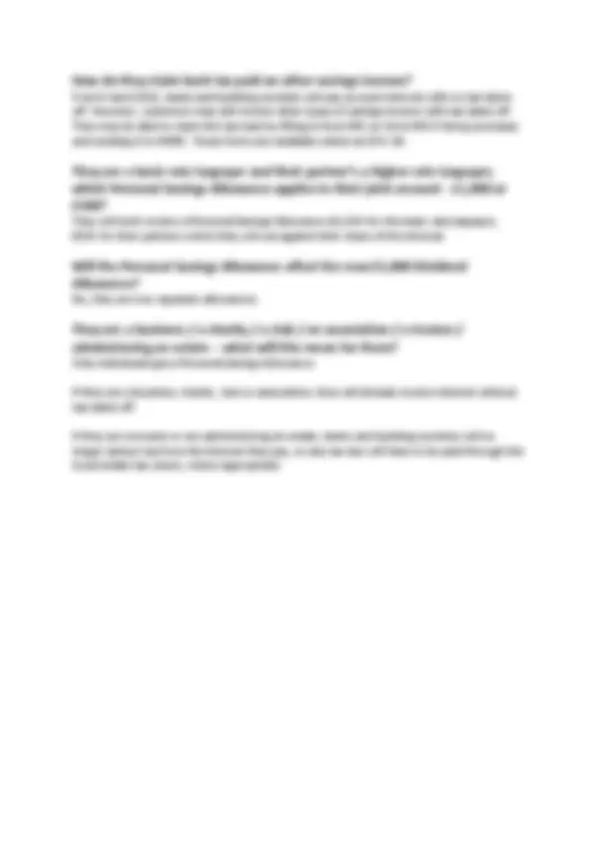



Study with the several resources on Docsity

Earn points by helping other students or get them with a premium plan


Prepare for your exams
Study with the several resources on Docsity

Earn points to download
Earn points by helping other students or get them with a premium plan
Community
Ask the community for help and clear up your study doubts
Discover the best universities in your country according to Docsity users
Free resources
Download our free guides on studying techniques, anxiety management strategies, and thesis advice from Docsity tutors
An overview of the personal savings allowance introduced in the uk from april 2016. It explains what savings income is, how it is taxed, and the new tax-free allowances for basic and higher rate taxpayers. It also covers questions related to isas, taxable income, and claiming back tax.
Typology: Summaries
1 / 3

This page cannot be seen from the preview
Don't miss anything!


From 6 April 2016, taxpayers will have a new Personal Savings Allowance. This means that up to £1,000 of income from savings (e.g. any interest earned) will be tax-free for basic taxpayers, and up to £500 of savings income will be tax-free for higher rate taxpayers.
Currently, banks and building societies are required to take basic rate tax from their customers’ savings interest. From 6 April, they will stop doing this because the vast majority of people will have no tax to pay on this income.
There is no action for most customers to take. Those with savings income below their new Personal Savings Allowance will have no tax to pay. Where possible, those with savings interest above their Personal Savings Allowance will have any tax they have to pay collected automatically by HMRC, through a change to their tax code - based on information provided by banks and building societies. Those who currently complete a Self Assessment tax return should continue to do so.
For further information about these changes, go to GOV.UK and search for Personal Savings Allowance. Full details will be added to the website in April when the new rules come into effect.
The following questions and answers should help customers who receive account interest from banks and building societies.
Savings income includes:
interest from banks, building societies and other account providers (such as credit unions and NS&I) interest distributions (but not dividend distributions) from authorised unit trusts, open-ended investment companies and investment trusts income from government or company bonds some types of purchased life annuity payments and gains from certain contracts for life insurance
No, income from ISAs does not count towards your Personal Savings Allowance.
No, changes only apply to savings income paid after 6 April 2016.
No, taxpayers do not need to give any information about their tax circumstances or other savings income to their account provider.
From 6 April 2016, if their total taxable income - for example, from wages, profits, pensions and savings - is less than £17,000, they won’t pay any tax on their savings income.
From 6 April 2016, if they are a basic rate taxpayer, up to £1,000 of their savings income will be tax-free.
For example, if they earn £20,000 a year and receive £250 in account interest, they won’t pay tax on their interest because it’s within their £1,000 Personal Savings Allowance.
If they earn £20,000 a year and receive £1,500 in account interest, they only need to pay tax on £500 of interest because their Personal Savings Allowance covers £1,000.
From 6 April 2016, if they are a higher rate taxpayer, up to £500 of their savings income will be tax-free.
For example, if they earn £60,000 a year and receive £250 in account interest, they won’t pay any tax on their interest because it’s within their £500 Personal Savings Allowance.
If they earn £60,000 a year and receive £1,100 in account interest, they only need to pay tax on £600 of interest because their Personal Savings Allowance covers £500.
No, they will not receive a Personal Savings Allowance.
They do not need to do anything because from 6 April 2016 all account interest will be paid without tax taken off.
Banks and building societies will still be required to take tax from any compensation interest paid. Customers may be able to claim the tax back by filling in form R40 (or form R43 if living overseas) and sending it to HMRC. These forms are available online at GOV.UK.